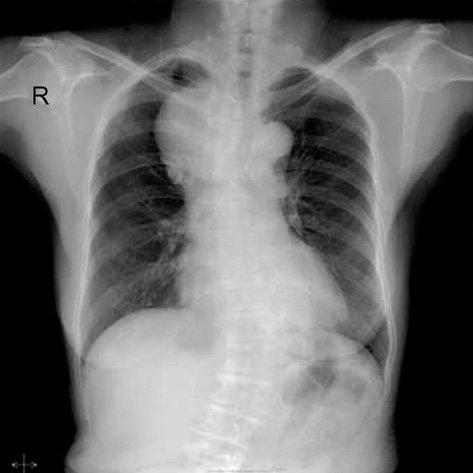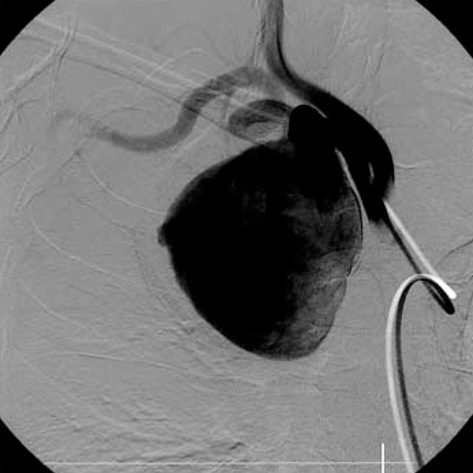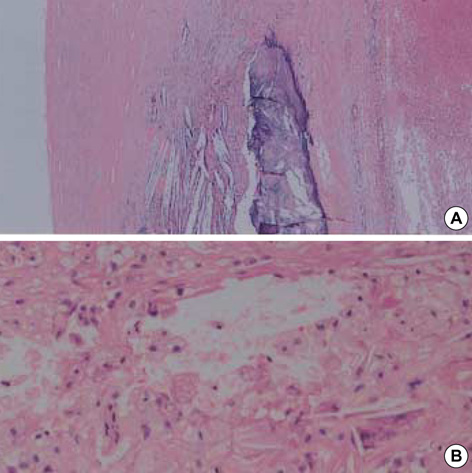J Korean Med Sci.
2005 Aug;20(4):674-676. 10.3346/jkms.2005.20.4.674.
Intrathoracic Aneurysm of the Right Subclavian Artery Presenting with Hoarseness: A Case Report
- Affiliations
-
- 1Department of Internal Medicine, College of Medicine, The Catholic University of Korea, Seoul, Korea. jsskim@catholic.ac.kr
- 2Department of Thoracic Surgery, College of Medicine, The Catholic University of Korea, Seoul, Korea.
- KMID: 1712753
- DOI: http://doi.org/10.3346/jkms.2005.20.4.674
Abstract
- Intrathoracic segment of the subclavian artery is an unusual location for peripheral arterial aneurysms. They are normally caused by atherosclerosis, medial degeneration, trauma, and infection. We report a case of a patient with right subclavian artery aneurysm presenting with hoarseness. Chest radiograph demonstrated a superior mediastinal mass. Laryngoscopy showed a fixed right vocal cord. By chest computed tomography, magnetic resonance imaging, and angiography, preoperative diagnosis was established as a saccular aneurysm with afferent loop and efferent loop. Patient underwent complete resection of the aneurysm followed by endto-end anastomosis via median sternotomy. Postoperative pathology was consistent with an atherosclerotic aneurysm filled with thrombus. After surgical operation, hoarseness is still continued.
Keyword
MeSH Terms
Figure
Cited by 1 articles
-
CT Evaluation of Vocal Cord Paralysis due to Thoracic Diseases: A 10-Year Retrospective Study
Sun Wha Song, Beom Cho Jun, Kwang Jae Cho, Sungwon Lee, Young Joo Kim, Seog Hee Park
Yonsei Med J. 2011;52(5):831-837. doi: 10.3349/ymj.2011.52.5.831.
Reference
-
1. Chung YC, Jeong UG, Cho YK. A case report of subclavian arterial aneurysm. J Korean Surg Soc. 1978. 20:83–86.2. Kim HJ, Kim SS, Huh JD, Chun BH, Joh YD, Cho SR. Intrathoracic aneurysm of the right subclavian artery. J Korean Radiol Soc. 1989. 25:725–727.3. Kim HK, Kim KH, Park YS, Lee WH, Chug EC, Han WS. Subclavian artery aneurysm: Report of a case. Korean J Thorac Cardiovasc Surg. 1993. 26:557–559.4. Dougherty MJ, Calligaro KD, Savarese RP, DeLaurentis DA. Atherosclerotic aneurysm of the intrathoracic subclavian artery: a case report and review of the literature. J Vasc Surg. 1995. 21:521–529.
Article5. Witz M, Yahel J, Lehmann JM. Subclavian artery aneurysms. A report of 2 cases and a review of the literature. J Cardiovasc Surg. 1998. 39:429–432.6. Davidovic LB, Markovic DM, Pejkic SD, Kovacevic NS, Colic MM, Doric PM. Subclavian artery aneurysms. Asian J Surg. 2003. 26:7–11.7. Utikal P, Bachleda P, Kocher M, Novotny J, Drac P, Drac P. Aneurysm of the subclavian artery. Acta Univ Palacki Olomuc Fac Med. 1999. 142:107–109.8. Hogg JP, Dominic AJ, Counselman RL, Hurst JL. Expanding aneurysm of aberrant right subclavian artery. Case report and imaging evaluation. Clin Imaging. 1997. 21:195–199.
Article9. Takagi H, Mori Y, Umeda Y, Fukumoto Y, Yoshida K, Shimokawa K, Hirose H. Proximal left subclavian artery aneurysm presenting hemoptysis, hoarseness, and diplopia: repair through partial cardiopulmonary bypass and perfusion of the left common carotid artery. Ann Vasc Surg. 2003. 17:461–463.
Article10. Salo JA, Ala-Kulju K, Heikkinen L, Bondestam S, Ketonen P, Luosto R. Diagnosis and treatment of subclavian artery aneurysms. Eur J Vasc Surg. 1990. 4:271–274.
Article11. McCann RL. Basic data related to peripheral artery aneurysms. Ann Vasc Surg. 1990. 4:411–414.
Article12. Kim DK, Yoon YS, Choi SH, Lee DI, Lee DY, Chang BC, Shim WH. A case of transluminal stent-graft implantation at right subclavian artery pseudoaneurysm in Behcet's syndrome. Korean Circ J. 1999. 29:1240–1244.
Article13. Ko KH, Won JW, Won JY, Lee DY, No KS, Lee JT. Endoluminal placement of stent-graft for the treatment of peripheral saccular aneurysm. J Korean Radiol Soc. 2002. 46:213–219.
Article14. Schoder M, Cejna M, Holzenbein T, Bischof G, Lomoschitz F, Funovics M, Nobauer-Huhmann I, Sulzbacher I, Lammer J. Elective and emergent endovascular treatment of subclavian artery aneurysms and injuries. J Endovasc Ther. 2003. 10:58–65.
Article15. Kasirajan K, Matteson B, Marek JM, Langsfeld M. Covered stents for true subclavian aneurysms in patients with degenerative connective tissue disorders. J Endovasc Ther. 2003. 10:647–652.
Article
- Full Text Links
- Actions
-
Cited
- CITED
-
- Close
- Share
- Similar articles
-
- Mycotic Aneurysm of the Left Subclavian Artery Presenting as Mediastinal Abscess: Case Report
- Intrathoracic aneurysm of the right subclavian artery: A case report
- A hybrid operation in a patient with complex right subclavian artery aneurysm
- Aneurysm of the Proximal Subclavian Artery: A case report
- Endovascular Treatment of a Spontaneous Transverse Cervical Artery Aneurysm: A Case Report






